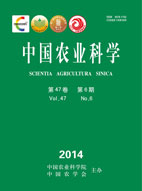-
Control Efficacy and Action Mechanism of Mineral Nutrition on Tobacco Bacterial Wilt
- ZHENG Shi-Yan, DING Wei, DU Gen-Ping, YANG Liang, LIU Xiao-Jiao, ZHANG Yong-Qiang
-
Scientia Agricultura Sinica. 2014, 47(6):
1099-1110.
doi:10.3864/j.issn.0578-1752.2014.06.006
-
 Abstract
(
581 )
Abstract
(
581 )
 HTML
(
4 )
HTML
(
4 )
 PDF (641KB)
(
1463
)
PDF (641KB)
(
1463
)
 Save
Save
-
References |
Related Articles |
Metrics
【Objective】 The objective of this study is to research the effect of four kinds of mineral nutrition (Ca, B, Mg and Mo) on tobacco bacterial wilt and defense enzyme activities, and discuss their mechanisms of action. Furthermore, from the perspective of control efficacy and physiological and biochemical regulation ways, finding out the crucial element related to control tobacco bacterial wilt closely.【Method】 A plot experiment was carried out repeatedly by means of greenhouse experiment combined with field test. Adding application of Ca, B, Mg and Mo nutrition for tobacco plant were individually with spraying. Subsequently, a comparison among control efficacies and defense enzymes activities of different treatments were carried out by investigating, detecting and analyzing the impact of different elements on occurrence of tobacco bacterial wilt, tobacco agronomical trait, direct inhibition and defense enzymes in tobacco plant.【Result】The greenhouse experiment results showed that, being on the basis of guaranteeing the basic nutrition, adding application of Ca, B, Mg and Mo all performed inhibition against tobacco bacterial wilt. However, the control efficacy of Mo treatment was significantly higher than others, followed by Ca nutrition, which were 64.79% and 57.67%, respectively. Besides, the areas under disease progress curve (AUDPC) of Mo and Ca treatments were significantly lower than others, which were 300.00, 244.44 (calculated with disease incidence) and 380.56, 352.78 (based on disease index) lower than control, respectively. Furthermore, there were direct inhibitions for Mo and Ca against Ralstonia solanacearum, the highest rate of which was 35.93% and 33.13% individually after treating 24 h. Additionally, Mo and Ca nutrition dramatically increased POD, CAT, SOD, PPO and PAL activities, and decreased MDA level in infected tobacco plant. Compared with the control treatment, which raised 3.11, 1.10, 0.82, 1.68 and 0.60 times, and 1.26, 0.73, 0.90, 1.00 and 0.32 times in turn, reduced 0.50 and 0.26 times, respectively. Moreover, the field experiments results showed that, supplying with Ca, B, Mg and Mo to tobacco plant, which were cultivated in tobacco-growing soil existing nutrition unbalance, tobacco bacterial wilt was controlled effectively. And the field control effects of Mo and Ca treatments were higher than any others, which were 49.46%-65.52%, 46.80%-57.40% (2011) and 45.28%-62.17%, 42.91%-62.57% (2012), respectively. What’s more, in terms of tobacco agronomical characteristics, Mo and Ca nutrition showed distinctly acceleration in the field, particularly plant height, width and area of maximum leaf and stem diameter.【Conclusion】The condition of tobacco nutrient level is closely related to its resistance. Replenishing tobacco with Mo and Ca nutrition regularly will benefit to enhance the defense ability of tobacco against bacterial wilt, and improve tobacco resistance to bacterial wilt. Besides, there is an obvious control effect against tobacco bacterial wilt. Furthermore, the above results would play an increasingly important role in the construction of nutrition-disease resistance model on plant diseases.









